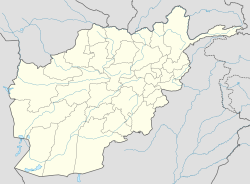卡拉特
外觀
| 卡拉特 قلات | |
|---|---|
| 坐標:32°06′22″N 66°54′25″E / 32.1061°N 66.9069°E | |
| 國家 | |
| 省 | 扎布爾省 |
| 人口(2006年) | |
| • 總計 | 9,900人 |
卡拉特(波斯語:قلات)位於阿富汗南部,是扎布爾省的首府。當地59%的土地都是荒地。[1]
卡爾吉王朝的創始人就來自於此。[2][3][4]2021年8月13日,塔利班控制卡拉特,成為2021年塔利班攻勢期間第17個被占領的省會城市。[5]
參考文獻
[編輯]- ^ State of Afghan Cities report 2015 (Volume-I English). UN-Habitat. [2025-05-11].
- ^ Ashirbadi Lal Srivastava. The History of India, 1000 A.D.-1707 A.D. Second. Shiva Lal Agarwala. 1966: 98. OCLC 575452554:"His ancestors, after having migrated from Turkistan, had lived for over 200 years in the Helmand valley and Lamghan, parts of Afghanistan called Garmasir or the hot region, and had adopted Afghan manners and customs. They were, therefore, wrongly looked upon as Afghans by the Turkish nobles in India as they had intermarried with local Afghans and adopted their customs and manners. They were looked down as non Turks by Turks."
- ^ Abraham Eraly. The Age of Wrath: A History of the Delhi Sultanate. Penguin Books. 2015: 126. ISBN 978-93-5118-658-8:"The prejudice of Turks was however misplaced in this case, for Khaljis were actually ethnic Turks. But they had settled in Afghanistan long before the Turkish rule was established there, and had over the centuries adopted Afghan customs and practices, intermarried with the local people, and were therefore looked down on as non-Turks by pure-bred Turks."
- ^ Radhey Shyam Chaurasia. History of medieval India: from 1000 A.D. to 1707 A.D.. Atlantic. 2002: 28. ISBN 81-269-0123-3:"The Khaljis were a Turkish tribe but having been long domiciled in Afghanistan, had adopted some Afghan habits and customs. They were treated as Afghans in Delhi Court. They were regarded as barbarians. The Turkish nobles had opposed the ascent of Jalal-ud-din to the throne of Delhi."
- ^ Taliban sweep across Afghanistan's south, take 3 more cities. AP NEWS. 2021-08-13 [2021-08-13]. (原始內容存檔於13 August 2021) (英語).
| 這是一篇與阿富汗相關的小作品。您可以透過編輯或修訂擴充其內容。 |

